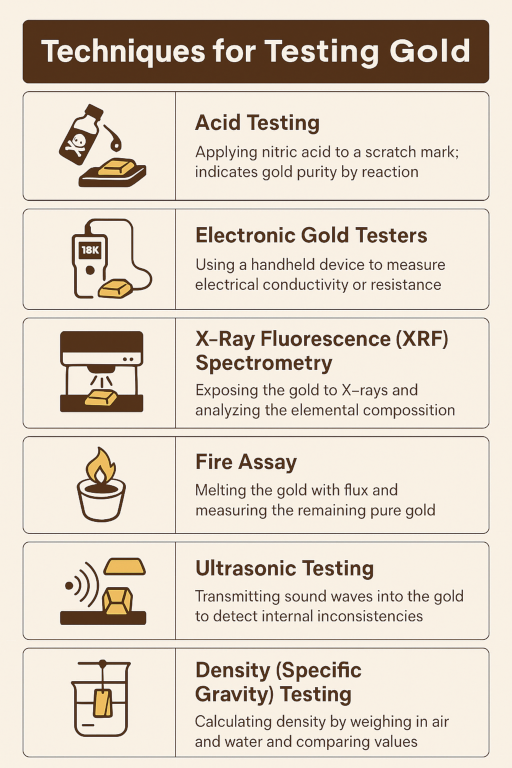
Gold has, for centuries, been regarded as a symbol of wealth, security, and investment stability. Whether in the form of jewellery, bullion, or industrial materials, verifying the authenticity and purity of gold is critical for both buyers and sellers. Numerous testing techniques exist, each offering varying levels of accuracy, invasiveness, and practicality. Understanding these methods is essential for anyone involved in the trade, valuation, or investment in gold.
This article outlines the principal techniques used to test gold, from traditional methods to modern scientific approaches.
Acid testing is one of the oldest and most commonly used methods for testing gold. It involves applying a drop of acid (typically nitric acid) onto the metal or onto a scratch made on a testing stone.
Procedure: A small scratch is made on a stone and different concentrations of acid are applied to determine the karat of the gold. If the metal dissolves, it indicates that the gold is of a lower purity than the acid was designed to test.
Advantages: Inexpensive, quick, and portable.
Disadvantages: Minor surface damage may occur, and results can be inaccurate if the gold is plated or alloyed.
Electronic testers measure the electrical conductivity or resistance of the metal to determine its gold content.
Procedure: A probe is applied to the surface, and the device gives a karat or percentage purity reading.
Advantages: Non-invasive, easy to use, and provides fast results.
Disadvantages: Surface contamination or plating can skew results; high-quality devices can be expensive.
XRF spectrometry is a highly sophisticated, non-destructive method employed primarily by professional laboratories, bullion dealers, and refiners.
Procedure: The metal is exposed to high-energy X-rays, causing the material to emit secondary X-rays that reveal the elemental composition.
Advantages: Accurate, non-invasive, and capable of detecting a full elemental breakdown, including trace metals.
Disadvantages: Equipment is expensive and requires proper calibration and training.
Fire assay is considered the most accurate method of gold testing, particularly for high-value transactions where precision is paramount.
Procedure: The gold sample is melted at extremely high temperatures with fluxes. Impurities are separated, and the remaining pure gold is weighed.
Advantages: Provides exact gold content with a very low margin of error.
Disadvantages: Destructive to the sample, time-consuming, and requires specialized laboratory facilities.
Ultrasonic testing is used to detect subsurface defects or inconsistencies within gold objects.
Procedure: High-frequency sound waves are transmitted into the metal. Reflections or changes in the waves indicate inconsistencies.
Advantages: Non-destructive and effective at detecting fake inserts within gold bars.
Disadvantages: Requires skilled operation and cannot determine purity directly.
Density testing relies on the unique density of gold (approximately 19.32 g/cm³) to distinguish it from counterfeit materials.
Procedure: The weight of the gold object is measured in air and then in water to calculate its density.
Advantages: Simple, cost-effective, and non-destructive.
Disadvantages: Results can be skewed by voids, alloys, or gold-plated items.
Each technique of testing gold offers distinct advantages depending on the context in which it is employed. While acid testing and electronic testers may suffice for everyday assessments, high-value trades or regulatory compliance often demand the precision of XRF spectrometry or fire assay. In many cases, a combination of methods is employed to ensure absolute confidence in the authenticity and purity of the gold.
Understanding these techniques empowers buyers, sellers, and investors alike to navigate the gold market with greater assurance and professionalism.
We use cookies to give you the best online experience. By agreeing you accept the use of cookies in accordance with our cookie policy.